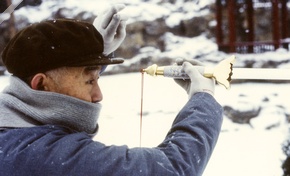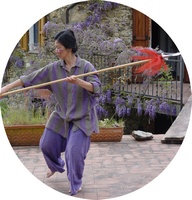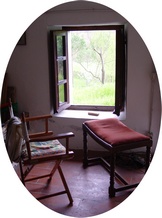
excerpt
Reasons to Stand
How is it that in order to move, I must first stand still? Ever since ZhanZhuang, the practice of standing, was introduced as part of my taiji training, my concept of movement has undergone moultings.
For nineteen years, I had understood taiji as a discipline that keeps the body fit and lithe, light and flexible. It had not been difficult to memorize the moves of the Yang Style 108 form, nor the state-sponsored 24 and 48 Forms. I learned them quickly and did them with the sense of satisfaction that one has doing something one can do.
 Learning the 48 and the Sword in the Beijing snow had been fun, and I very much appreciated the kindness of the man who taught me so generously every morning in the winter of 1986. I had found myself avoiding those who were keen to teach me Chen Style, although I had strong interest in the subject. I happily settled into a group in the park at Ritan, Temple of the Sun, in Beijing. It was an odd collection of men and women, the eldest being eighty-two years old, the next oldest seventy-four. The latter, very sprightly, had a gold tooth that was of significance to my practice that winter. We began the lesson in pitch darkness, and when the first sunray lit that gold tooth and hit my sword’s tip, I knew I would soon be able to see what the teacher was teaching. Full of zest I woke up before 5am and walked to Ritan, past the man standing still by the tree (hey!), the woman circling another tree, another woman singing her head off by the wall, every morning for nearly three months with the temperatures plummeting.
Learning the 48 and the Sword in the Beijing snow had been fun, and I very much appreciated the kindness of the man who taught me so generously every morning in the winter of 1986. I had found myself avoiding those who were keen to teach me Chen Style, although I had strong interest in the subject. I happily settled into a group in the park at Ritan, Temple of the Sun, in Beijing. It was an odd collection of men and women, the eldest being eighty-two years old, the next oldest seventy-four. The latter, very sprightly, had a gold tooth that was of significance to my practice that winter. We began the lesson in pitch darkness, and when the first sunray lit that gold tooth and hit my sword’s tip, I knew I would soon be able to see what the teacher was teaching. Full of zest I woke up before 5am and walked to Ritan, past the man standing still by the tree (hey!), the woman circling another tree, another woman singing her head off by the wall, every morning for nearly three months with the temperatures plummeting.
 Then, at seventeen degrees below zero, I headed for Yunnan, ‘south of the clouds’.
Then, at seventeen degrees below zero, I headed for Yunnan, ‘south of the clouds’.
The Beijing experience, and the Kunming experience, were confluent with what I understood as T’aiChiCh’uan (both spellings).
What was it that changed, in 1995 when I met Chen XiaoWang, and in 1996 when Ben and I followed him to Australia? Mulling over it all now, I realize it was ZhanZhuang that brought the dawn.
ZhanZhuang, ‘Standing Pole’ – the pole that connects Heaven and Earth – is a practice in its own right. One could have it as the only practice that one did. It is sometimes referred to as Wuji ZhanZhuang – merging with the void.
When T’aiChiCh’uan was introduced into Europe and America in the 1950s and 60s, it was quite unapparent that ZhanZhuang was a major part of the traditional curriculum. It was not until the 1980s, or even to some extent the 1990s, that a fuller picture became generally available. Descriptions of a traditional training, such as the following from Feng ZhiQiang, would have been met with incredulity by most of the early European and American practitioners. Here he describes his training with Chen FaKe in Beijing between 1951 and 1957:
When I was studying under him, I had to train very hard. Every morning I had to get up at 4:30 and train until 11:30, a total of seven hours a day. The training started with two hours of Wuji Zhan Zhuang, Xinyi Qigong, followed by practising the form; after the form each individual posture and eventually push-hand.
When we arrived in Sydney and went to pay our first visit to Master Chen at his house, we caught glimpses of the lesson he was giving to two pupils in the garden. Peeping out from the window, I saw them standing still with their arms up, in the shady practice area beneath the trees. Surprised, I said to Ben, “They are standing!” Fifteen minutes later when I took another peep, I heard myself saying, “Ben, look! They are still standing!” And so did we, when our lessons began.
Staying at the Chen house in Sydney, we would see our teacher standing in the garden first thing every morning. Later, when we or others having lessons were in ZhanZhuang, he would stand again with us, after twenty minutes or so of giving adjustments to our postures, a few tweaks at a time, with pauses in between while he contemplated his life and we tried to accept our present. Ben and I had jumped into the deep end, and we started off our ZhanZhuang life with half-hour standings. As challenging as this was, we soon got used to it and before the year was out, we were into one-hour standings as part of our daily practice.
|
next |

